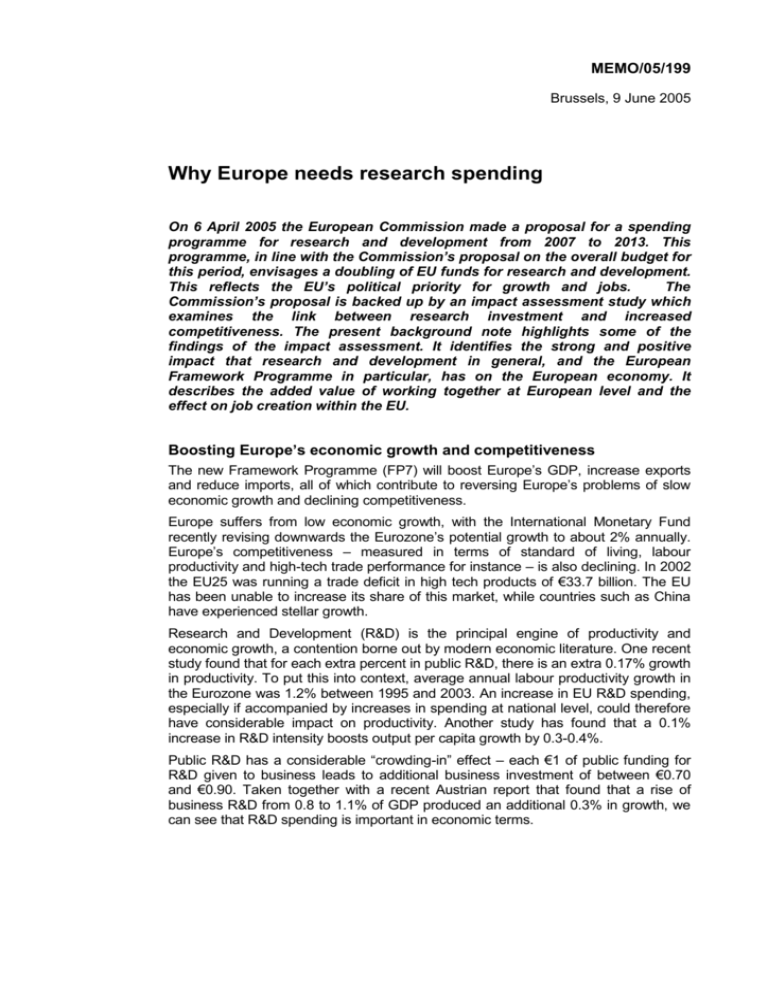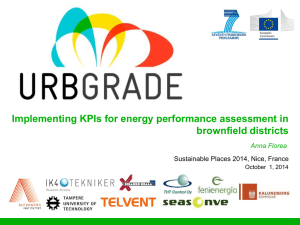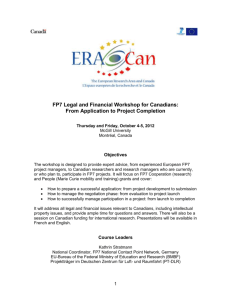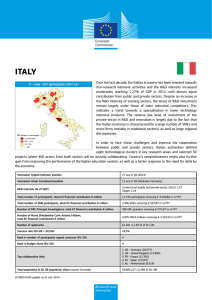DOC
advertisement

MEMO/05/199 Brussels, 9 June 2005 Why Europe needs research spending On 6 April 2005 the European Commission made a proposal for a spending programme for research and development from 2007 to 2013. This programme, in line with the Commission’s proposal on the overall budget for this period, envisages a doubling of EU funds for research and development. This reflects the EU’s political priority for growth and jobs. The Commission’s proposal is backed up by an impact assessment study which examines the link between research investment and increased competitiveness. The present background note highlights some of the findings of the impact assessment. It identifies the strong and positive impact that research and development in general, and the European Framework Programme in particular, has on the European economy. It describes the added value of working together at European level and the effect on job creation within the EU. Boosting Europe’s economic growth and competitiveness The new Framework Programme (FP7) will boost Europe’s GDP, increase exports and reduce imports, all of which contribute to reversing Europe’s problems of slow economic growth and declining competitiveness. Europe suffers from low economic growth, with the International Monetary Fund recently revising downwards the Eurozone’s potential growth to about 2% annually. Europe’s competitiveness – measured in terms of standard of living, labour productivity and high-tech trade performance for instance – is also declining. In 2002 the EU25 was running a trade deficit in high tech products of €33.7 billion. The EU has been unable to increase its share of this market, while countries such as China have experienced stellar growth. Research and Development (R&D) is the principal engine of productivity and economic growth, a contention borne out by modern economic literature. One recent study found that for each extra percent in public R&D, there is an extra 0.17% growth in productivity. To put this into context, average annual labour productivity growth in the Eurozone was 1.2% between 1995 and 2003. An increase in EU R&D spending, especially if accompanied by increases in spending at national level, could therefore have considerable impact on productivity. Another study has found that a 0.1% increase in R&D intensity boosts output per capita growth by 0.3-0.4%. Public R&D has a considerable “crowding-in” effect – each €1 of public funding for R&D given to business leads to additional business investment of between €0.70 and €0.90. Taken together with a recent Austrian report that found that a rise of business R&D from 0.8 to 1.1% of GDP produced an additional 0.3% in growth, we can see that R&D spending is important in economic terms. This is a key point in mobilising private sector investment in research, which should contribute two-thirds of the R&D spending target of 3% of GDP. Last year’s EU Industrial R&D Investment Scoreboard showed that investment by the top 500 R&D spending companies in the EU in 2003 was 2% down on 2002, while it grew by 4% for the top 500 companies outside the EU. The impact assessment includes the following table outlining the different scenarios for investment in R&D at European level, as compared to a moderate increase in FP7 funding: Doubling funding under FP7, rapid growth in FP funding thereafter Indicator No FP7 Doubling funding under FP7, moderate growth in FP funding thereafter Extra GDP (%) Extra GDP when taking account of increases over time in the quality of products (%) Change in exports to outside Europe (%) Change in imports from outside Europe (%) - 0.84 + 0.45 + 0.96 - 1.31 + 0.69 + 1.66 - 1.92 + 0.64 + 1.57 + 1.43 - 0.27 - 0.88 Source: Adapted Nemesis econometric model These projections rely on a number of important assumptions: - Member States will not reduce national investment - FP7 projects will be at least as successful as past FPs and national projects in attracting complementary private sector funding. - FP7 will allow smooth conversion of new knowledge into new products, processes and services. FP7 can also provide the necessary framework conditions to attract foreign R&D investment. Currently, the EU is losing R&D investment to other countries; the diagram below shows flows of R&D funding. 948 13 644 USA 15 399 Total Business Sector 182 784 EU 574 Total Business Sector 10 362 110 094 Japan Total Business Sector 1 827 70 448 1 418 Source: Adapted OECD, Activity of Foreign Affiliates database and Secretariat estimates In 2001 there was a net outflow of R&D funding from the EU amounting to over €6 billion. 2 Strengthening Europe’s human resources In employment as with economic growth, the European outlook is worrying, with 9.1% unemployment across EU15 in 2003. Analysts are noting an increase in longterm unemployment and the deterioration of labour markets. While these problems are particularly acute for the low-skilled, there is also a shortage of high-skilled people, especially researchers. This calls into question the EU’s ability to reach its target of 3% of GDP invested in R&D by 2010, which will require at least 700,000 additional researchers according to latest estimates. An increased budget for European R&D could have a major impact on employment, creating as many as 1 million jobs by 2030. By supporting future-oriented industries, FP7 will support those sectors of the economy that hire more high-skilled people and pay them better, and create more employment than average: between 1997 and 2002 the growth rate was 11.9% for total high-technology sector employment and 16.2% for knowledge-intensive industries, as compared to 8.1% for total employment. A recent Commission study found that technological change promotes employment – countries with higher than average increases in the rate of growth of Total Factor Productivity (TFP – related to improvements in the efficiency of production of technological progress) also tend to have higher than average employment growth. Again, compared with a moderate increase in funds under FP7, we can see that doubling of funds would have significant effect on employment in the EU: Indicator + 418,000 Doubling funding under FP7, rapid growth thereafter + 925,000 + 40,000 + 214,000 Doubling funding under FP7, moderate growth thereafter No FP7 Extra employment (#) - 840,000 Extra jobs in research -87,000 (#) Source: Adapted Nemesis econometric model Investing at European level to add value There are many good reasons to fund projects at European level. By doing so, the EU encourages researchers to co-operate across national boundaries and to share complementary skills and knowledge. This maximises scarce resources and reduces wasteful duplication of research spending: better value for tax payers’ money. Many research activities are of such a scale and complexity that no single Member State can provide the necessary resources. EU funding enables partners to pool their funds, facilities and knowledge, culminating in a critical mass that would not be possible at national level. Concrete examples of this phenomenon include the Network of Excellence on Allergies and Asthma, or the Construction Technology Platform. By working at European level, industry has better access to the knowledge it needs, and researchers have more certainty that their work will be taken up. By providing a framework for disseminating research results across Europe, FP7 will increase the chances of their being transformed into innovative products, processes and services. 3 Increased competition is an effective way of promoting higher quality and excellence. The creation of a European Research Council to support cutting-edge frontier research should take this one step further, with individuals or teams selected by their scientific peers. Higher quality output and more dynamism in research will boost the European knowledge and industry base. National research programmes still account for the vast bulk of public research spending in the EU. However, there is considerable overlap in some areas, while other areas are insufficiently covered. By improving the coordination of Member States’ activities, while at the same time addressing issues that are not given sufficient attention in national programmes, FP7 will ensure more efficient spending on R&D across Europe, and foster sectors with significant potential. For example, though FP6 represented 5-6% of total EU public R&D expenditure in general, it represented much more in some cutting-edge areas with high-growth potential, i.e. up to 30% of public investment in nanotechnology. 4










